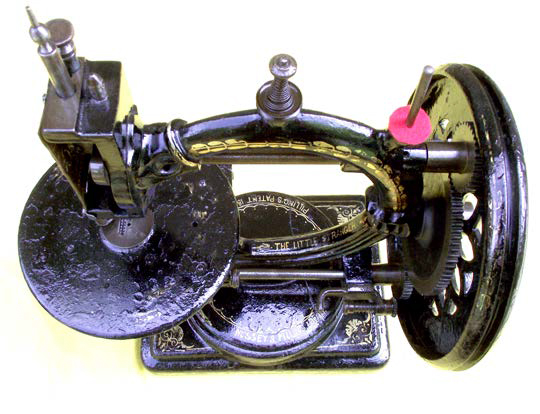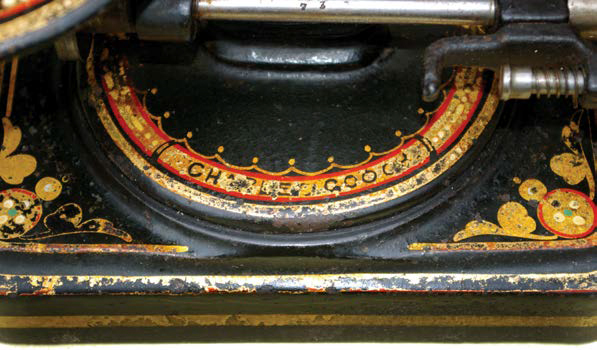Befriending "The Little Stranger"

Fig. 9: The earliest version with bronze clothplate and fancy cast iron base
The British domestic sewing machine market in the 1870s was flooded with small hand shuttle machines which were passable for mending clothes and household textiles but not robust enough to earn one's living with. For the professional seamstress Singer, Wheeler and Wilson and their clones made by others provided REAL sewing machines.
Popular small hand shuttle machines included the 'Shakespear' and the 'Agenoria' which are well known to most collectors. Most of these small hand shuttle machines retailed at four guineas (£4.20). One of the less well known was 'The Little Stranger' made by the Leeds firm of Nussey & Pilling. In its basic form it was launched at three guineas (£3.15) in 1869 but was soon 'improved' and 'decorated with mother-of-pearl' so that its price went up to four guineas.
Arthur Nussey and Altham Pilling established their company at the Park Works, Park Lane, Leeds in the late 1860s. Pilling had taken out his first patent in March 1866 for a heavyweight rotary hook machine for which no evidence of manufacture exists. The company's first production machines were clones of the Wheeler & Wilson curved needle machine for which they claimed several 'extraordinary improvements' available for 10 shillings (50 p) extra.

Fig. 1: The brass front plate on the Little Stranger

Fig. 2:'The Little Stranger' by Nussey and Pilling.

Fig. 3: The new front plate of 'The Improved Little Stranger' with thread take-up spring.

Fig. 4: The shuttle assembly linkage to make it move in an elliptical path

Fig. 6: The first flywheel was solid, this shows the second design of flywheel.

Fig. 7: The 'Improved Little Stranger' on its single pillar stand.
The Wheeler & Wilson clone was aimed at the professional seamstress, as was the 'Noiseless Tudor', a full size transverse shuttle lockstitch machine with a forward facing flywheel rather like the layout of the W. F. Thomas free-arm machine but without the free-arm.
Their entry into the budget domestic market was 'The Little Stranger' of 1869. This was a small "C"-framed machine about the size of the W&G, but sewing a lockstitch. The only feature which differentiated this machine from its competitors such as the 'Little Wanzer' and the 'Shakespear' was the shuttle which moved in an elliptical path. This feature was copied from William Taylor's patent machines and was supposed to reduce noise as the shuttle moved continuously round an ellipse rather than rattling back and forth between stops at the ends of a shuttle race. The machines carry the legend 'Pilling's Patent 1866' but this patent is not relevant to the machine. The machines do not carry serial numbers which makes dating difficult and estimates of numbers manufactured, impossible!
A report in 1872 claimed that the company had invested a lot of money in plant for interchangeable manufacture. They claimed to use 123 special tools, jigs and gauges to ensure accuracy in making 'The Little Stranger'.
Division of labour meant that each machine 'passes through more than 100 distinct processes, each by a separate workman.' Once assembled, machines were mounted on a bench driven by steam power where 'each machine is thus put through a severe trial.' After final examination and inspection, 'it is then taken in hand by an experienced operator, by whose manipulation it is made to produce specimens of sewing which guarantee that it is fit to go into the household.' 'Trial run', 'testing', 'manipulation', do not suggest that the machines used interchangeable parts,- they are terms used by the 'file and fit' brigade and examination of surviving machines suggest that this is so. The reporter was fed a story about interchangeable manufacture and fell for it!

Fig. 5: The change in name to 'The Improved Little Stranger'

Fig. 8: The elegant single pillar stand and hexagonal cover.
The basic machine on a very heavy cast iron base retailed at three guineas and a machine ' inlaid with Pearl and Burnished Gold' retailed at four guineas. The latter 'we recommend as it is a work of art as well as a perfect sewing machine'. There was also a version with a polished bronze clothplate and an ornate cast iron base. The basic machine was fairly crude and so was quickly followed by ' The Improved Little Stranger'. This also was available in plain form or the highly decorated form. The improvements consisted of replacing the brass front plate with a steel plate carrying a simple spring operated thread take-up and a revised cloth feed adjuster which, while still uncalibrated, could, at least, be set reproducibly. 'The Improved Little Stranger' started at four guineas and was offered as a hand machine and on a single pillar stand. Boxes for the hand machine ranged from 4 shillings (20 p) for a plain deal box with handle and drawer to a polished walnut travelling case with lock, drawer and compartments for cottons, needles etcetera for £1 – 5s (£1.25). The basic single pillar iron stand and top cost one guinea (£1.05) but at the top of the range came the machine AND stand inlaid with pearl and burnished gold on a very handsome walnut table with ornamental hexagonal cover at seven guineas (£7.35).
Nussey and Pilling had a London agent, S. W. Silver & Co. As usual, the company would supply badged machines for other distributors and so Little Strangers have turned up carrying the names 'The Byron', 'Sandwich', 'Abigail' and 'Little Wonder'. Altham Pilling left the partnership in July 1874 after which the company became Nussey & Co. The last entry for the company in a Leeds directory is in 1878 so production lasted around ten years.

Fig. 9: The mother-of-pearl version badged as 'The Byron'

Fig. 8: The solid flywheel of 'The Byron' encrusted with mother-of-pearl

Fig. 11: A version badged for Charles Gooch, presumably a retail dealer

Fig. 10: The non-standard flywheel of the earliest version

Fig. 12: Gooch's name proudly displayed.






